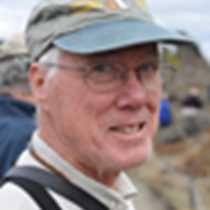Kapp Weyprecht, East Spitsbergen, Svalbard
It was a day doing battle with the Arctic winds. Potential landing sites on the large islands of Edgeøya and Barentsøya were rejected in turn as fierce winds swept through Freemundsund, the narrow passage between the two islands. Our Expedition Leader and Captain huddled over the chart table looking for a landing site that offered enough protection to allow our first shore excursion of this voyage. Their hard work and experience paid off. In late afternoon we approached Kapp Weyprecht, near the easternmost corner of Spitsbergen. It is likely that the glacial ice retreated from this small bit of exposed land within the past few centuries to millennia at the most—a mere blink of a geologist’s eye. Our first view was of hordes of seabirds—kittiwakes, fulmars, Arctic terns, and glaucous gulls—in a feeding frenzy where a silt-laden river of fresh water rushing down from the glacier emptied into the sea. A plankton tow, viewed through the ship’s video microscope, revealed an abundance of myscid crustaceans, arrow worms, and copepods—food for the hungry birds.
Looking from the deck of Endeavour we saw a stark, almost lunar landscape. The Captain looked out and challenged the Naturalist: “This will be a geology landing; you might not find many plants there.” The Naturalist accepted the challenge. After dinner we bundled up and landed on the silty beach, and then walked up a series of ancient beaches that are now well above the water line. Driftwood and the bony remains of marine mammals, now half-buried in tundra, tell a story of the rebound of land as it is released from the mass of glacial ice. That same stroll took us from land only recently raised from the sea, with a colonizing plant community, to older, fully-vegetated surfaces supporting a rich community of tundra plants: tufted (above) and purple saxifrages in bright flower, and delicate Svalbard poppies. Mats of Polar willow showed yellow just appearing in the leaves, the first sign of the approaching Arctic winter. We returned to the beach for a cup of warm glög as the sun dipped towards, but never quite reached, the horizon in the northern sky: tiny, beautiful tundra plants viewed in the light of the Midnight Sun.




